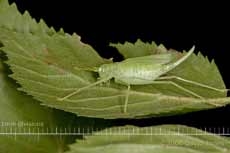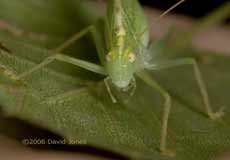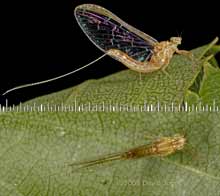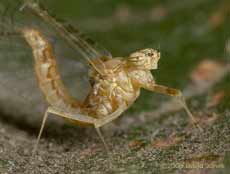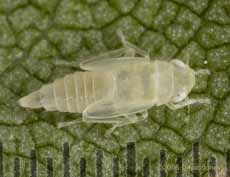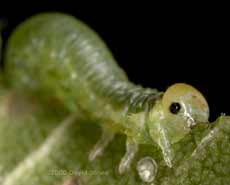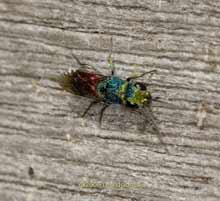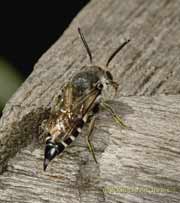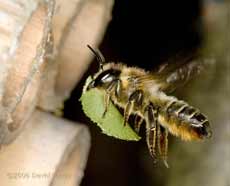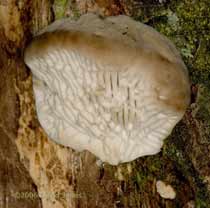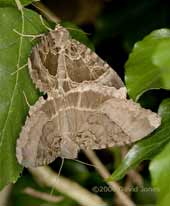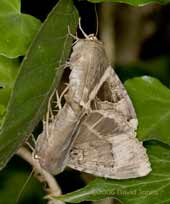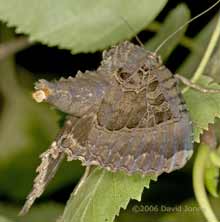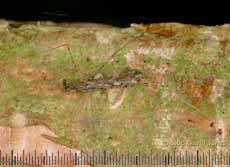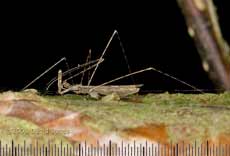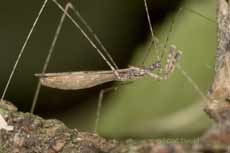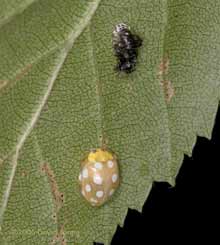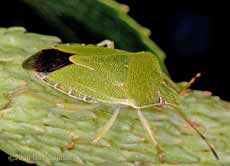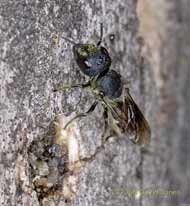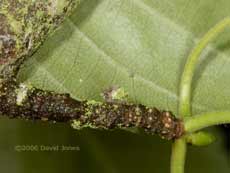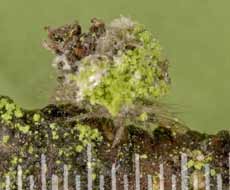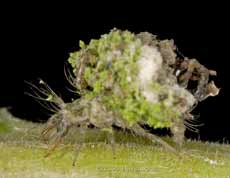Go to the last entry on this page .....Go to previous entry23 August - Dull and overcast, with low cloud but just a few drops of rain during the day, although it is looking more threatening as the evening starts (in fact, at 5.30pm it is drizzling -very miserable!). For me it has been a 'day off', having done too much in the garden over the last week, but I have picked up my camera a couple of times.
I took this photograph at around 8.30am and the cricket is still in the same place at 5.30pm.
Although I've seen crickets like this in the garden many times in the past, I'm still uncertain as to which species it is. I think this one is probably still immature, which doesn't help. It could be the Great Green Bush-cricket (Tettigonia viridissima or T. cantans), although I think it is more likely to be a Long-winged Conehead (Conocephalus discolor). Tim Norris has come to my aid again - it's an adult female Oak Bush-cricket.
A much more delicate surprise greeted me under another leaf in the form of this Mayfly. It only has a single pair of wings, which rules out many species, and the nearest match in my Collins Insect Guide is Chloeon dipterum, a species that breeds in ponds ditches and even water butts, and can be found between May and October.
The yellowish brown leading edge of the wings suggests that this is a female.
In my previous diary entry I included a photograph of an adult leaf-hopper. I think that this may be a newly moulted nymph of the same species.
Finally, this was the only sawfly larva that I could see in action on the Birch this morning.
It looks as though rain will prevent me from using the camera under the Birch tree this evening! There was still a bit of activity by the leaf-cutter bees today, but I have still not taken any photographs - I must do so in the next couple of days before it is too late for this year. Judging by the number of empty tubes, it has not been a particularly good year for them. The Ragwort flowers (as are the water mint flowers that I don't think I've mentioned this year!) are attracting hoverflies at the moment, with only the occasional solitary bee visiting them. Much of the garden looks pretty scruffy at the moment, with some bits untouched since the Summer holiday. I must turn my attention back to it in the next few days. We seem to have fewer visits by the juvenile Robins now. Perhaps the rivalry we were seeing has resulted in one moving out of this territory. The Goldfinch families continue to appear, and there are four or five Blue Tits coming frequently. Today we had a pair of adult Great Tits visit. The plumage of one in particular looked perfect - has it just completed a moult? There is still just the one Blackbird visiting, and no more than once or twice each day. I've added a short entry to the House Martin diary this afternoon. Since I took the photograph of the Hedgehog I have see no further sign of it, and the talcum powder failed to provide evidence that it was visiting the hedgehog house.
25 August - Just a short entry tonight. Today we have had the best weather since our return from Cornwall, and I took advantage to complete a job started yesterday, clearing behind our metal shed ready to set up a spot to grow plants from seeds or cuttings, and taking rubbish to our recycling centre. I have promised myself to 'take the weekend off', so I should be using my camera more over the next few days.
This afternoon Sheila called my attention to a Ruby-tailed wasp (probably Chrysis ignita) flying around the bird table and the Buddleia.
At the same time, this bee appeared around the Leaf-cutter bee tubes. I didn't manage to get a photograph of it there, but was able to get this shot when it perched on the bird table. I'm not certain about its identification, but it closely resembles a female Coelioxys inermis. This is a cuckoo species which lays its eggs in Leaf-cutter bee nests.
This evening Sheila and I were having our evening meal out on the veranda at around 7.30pm when hedgehog appeared and amused us by tucking into a piece of Wensleydale cheese (of Wallace and Gromet fame, but not to our taste) which we had put out ready for tomorrow's early birds. Last night, after dark I followed the progress of a pair of hedgehogs as one reversed just about the whole length of the garden, snorting loudly as the other followed closely, often trying to circle it. I decided not to disturb them by using my camera, but I did point my microphone at them as they trampled through the undergrowth. There is a short sample from my recording in the Sounds folder, or you can hear it by clicking here .
27 August - The nicest day since Cornwall - we had coffee down the West Wing for the first time in ages, and I took most of the day off doing anything in the garden.
Despite the warm, sunny weather I didn't see any activity at the bee hotels, although there was one Leaf-cutter bee working on its nest in a bamboo tube. I watched it over a period of several hours, but didn't see it take any pollen into the tube. There was no sign of the cuckoo bee that I saw two days ago.
Yesterday I made a microphone suspension rig to try improve the recordings I am making. This morning I tried it out when the Goldfinches turned up, and you can hear a bit of that recording by clicking here or by visiting the sounds folder.
Earlier in the summer one of my sons brought me some pieces of oak that were in early stages of decay. I fixed one of them on a support and drilled holes into it for insects to use. While it received only limited attention from insects, it is now sprouting fungal fruiting bodies. Searching through my fungi guides, the nearest match I can find is Daedalea quercina which grows on broad-leaved trees, especially Oaks.
30 August - Another gap as I try to catch up on long overdue jobs in the garden, especially clearing out lots of bits and pieces that have been horded away in corners. The recycling centre will be getting another visit from me tomorrow, and I now have a space where I can set up seed trays and cuttings. The weather has continued dry (except for a few rain drops) but it has become decidedly breezy and cooler - very autumnal. I've noticed some leaf-fall (still green) from the Birch over the last few days.
While I have been shifting things around in the garden I've disturbed several Old Lady moths. Over the last two nights I've seen pairs mating on the Birch and as in this case, on the Ivy. This is the first time I have seen these moths mating.
This view gives a more intimate view of the pair.
While they were completely involved with each other, about a foot away, on a Birch leaf this lone moth was obviously trying to attract a mate. I don't know if is a male or female, but I assume that the moth was busy producing pheromones.
I went down the garden tonight at around 8.30pm and there were several of these moths on the wing, but I couldn't find any that had settled on vegetation. I had to head back for the house when it started to rain, but if I can I will take another look before I head for bed.
While down the garden I did my usual check of the Birch. Things seemed very 'quiet' with only a few insects in sight, but I did find what at first glance looked like a gnat resting on the underside of a branch. It wasn't actually rest, but moving forwards with the very slow, deliberate steps of an animal stalking its prey.
It didn't look quite right for a gnat, and this was confirmed when I took a look from the side - it was closer in appearance to a miniature Praying Mantis, and requiring a look in my insect guides. The scales in these first two images have 0.25mm divisions.
My Collins guide suggests that it could be Empicoris vagabundus (or a similar species), an assassin bug that lives mainly in trees and which uses its raptorial front legs to catch aphis and other small insects. In this shot you can see its curved rostrum (piercing beak).
There are still very few Orange Ladybirds to be seen. I could see one newly emerged adult tonight and several larvae and pupae. Back between the 14th and 18th August I took several photographs of a larva as it pupated. On the 28th I took this photograph of the adult which had emerged that day.
Also on the 28th I found this Green Shield Bug on one of the birch's immature seed heads.
Since the 28th I haven't seen any activity around the bamboo tubes of the Leaf-cutter bees, but there have been a couple of bees active at the bee hotels, although they haven't been anywhere near as busy as earlier in the month.
31 August - The month has ended on a warm note. The winds swung round to the west, a warm breeze brought the temperature up to 25C in the garden this afternoon and it stayed dry. The rise in temperature was enough for me to call a halt to my continuing task of sorting out the hidden parts of the garden, but I've a bit more to do tomorrow before I can really call a halt for a few weeks. I ended the afternoon spending several hours at the front of the house watching the House Martins (see the birdbox diary).
Just one set of pictures for today, actually taken yesterday. When I spend time checking the Birch, although I'm usually looking for the obviously visible things, occasionally something else catches my eye, just like the small bit of debris at the side of this short branch - it moved!
A closer look revealed that it was quite 'hairy', and had legs (the scale has 0.25mm divisions). It was a larva of some sort, carrying a mixture of bark bits, algae and perhaps silk from webs(?) as camouflage.
As I watched it move about its jaws became obvious, and while I can't identify it, the larva closely resembles those of the lacewing larvae. If they are of that insect order (Neuroptera) then the jaws are actually tubes through which the larva sucks the juices of its prey, and the debris on its back may include the skins of victims!
|
|
